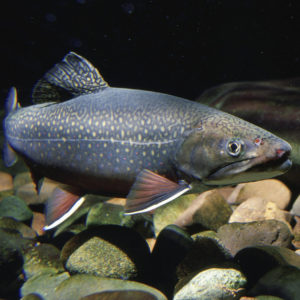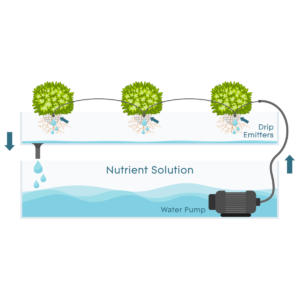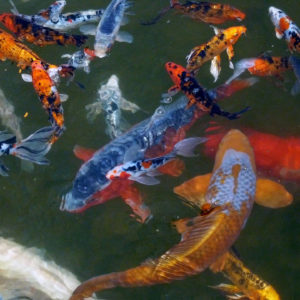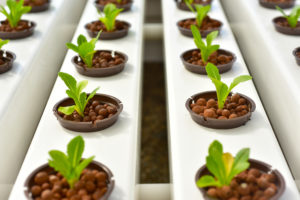How Does Aquaponics Work?
Aquaponics is a sustainable way to grow fish and produce at the same time. That sounds great, right? But, how exactly does aquaponics work?
The basic premise of aquaponics is that it combines aquaculture (which you may think of as somewhat like fish farming) and hydroponics. Of course, hydroponics is a form of agriculture that grows plants without soil. While aquaponics isn’t extremely complicated, it’s not as simple as just putting the two together.
How Aquaponics Combines Aquaculture and Hydroponics
In a hydroponic system, growers feed plants with nutrient enriched water called nutrient solution. However, fish really can’t tolerate high levels of most of the fertilizers you would use to feed plants in hydroponics. At the same time, your plants still need nutrients to live. So, how do you feed your plants and your fish?
Aquaponics is a symbiotic system. The plants and the fish rely on each other for sustenance and balance. Fish naturally produce waste, which goes into the tank they’re living in. The water from the tank also waters the plants. The fish waste works as a natural fertilizer which feeds the plants. However, you still need to feed your fish food from outside of that which they might get in accessing the plants.
While you still need to feed your fish, the plants provide several other benefits that the fish need to live. The plants help keep the water balanced, and as they use the nutrients from the fish waste, they inevitably end up cleaning the water that recirculates back to the fish tank.
What Kinds of Aquaponic Systems Are There?
The neat thing about aquaponics is how versatile it is. Since it’s a combination of aquaculture and hydroponics, you can more or less use the same types of systems as you would in hydroponics. And, they work pretty much the same way. Because the biggest differences are how you feed your plants, and the fact that you have fish in the tank, you have a lot of options. Chances are, if you can make it work for hydroponics, you can adjust it to work for aquaponics.
The main types of systems include:
- Drip
- Ebb and Flow (also called Flood and Drain)
- NFT (Nutrient Film Technique)
- DWC (Deep Water Culture)
- Wick
Learn more about different types of hydroponic systems.
One thing to keep in mind: be careful of using a recirculating system with a lightweight growing medium that can float back into the tank or clog drains.
Why Choose Aquaponics?
Aquaponics is a great example of agriculture that you can scale to fit your home, or a large commercial operation. However, that’s not the only reason you should choose to grow using aquaponics.
Here are other benefits to consider:
One system – two products
One of the most obvious benefits of aquaponics is that it allows you to grow two different types of food at once. You can grow a wide variety of vegetables and fish, without having to use space for two different systems. Not only that, there’s no waiting time between one harvest and the next.
Reduce fertilizer use
In aquaponics, the fish take care of feeding fish through the waste they produce. As a result, you really don’t need to worry about adding extra nutrients to the tank to maintain your plants. In fact, you only need to worry about feeding the fish- they’ll take care of the rest.
Less time until harvest
Aquaponics, much like hydroponics, allows plants to grow much more quickly. This means you have less time to wait until you can harvest them. However, your fish can also grow more quickly too. Because you have complete control over their environment, you can ensure that both the plants and fish have optimal conditions to grow their best.
Use less resources
It might seem like aquaponics would require a lot of water to work. However, it’s important to remember that aquaponics systems are recirculating. This means that the water that goes from the fish to the plants still returns back to the tank. Yes, you will have to add extra water from time to time, but that’s a relatively small amount compared to traditional agriculture.
Efficient use of space
Aquaponics is efficient in terms of resources, and space is a key resource for most home gardeners. You can produce large amounts of food with a very small footprint. Even tanks that reach only a handful or two of gallons of water can be used for a small home aquaponic system. Just make sure you choose fish that can grow in a small system, and don’t over stock your tank.
Effortlessly organic growing
These days, more people are becoming interested in not only eating organic food, but also in growing it for themselves. Here’s the thing about aquaponics: it’s almost inherently organic. Remember that fish can’t tolerate chemicals and pesticides. That ultimately means that if you want to grow in aquaponics (and keep your fish alive and well until harvest), you’ll almost certainly end up growing organic produce too.
Not sure what to grow? Learn about what types of fish you can grow in aquaponics.



